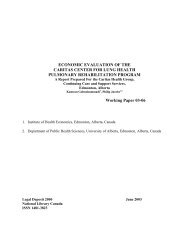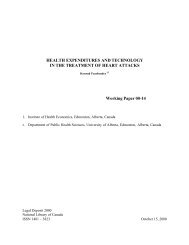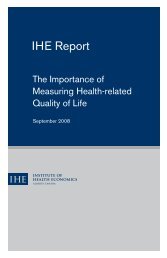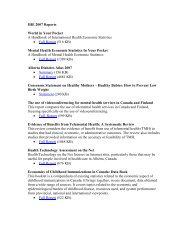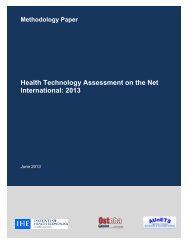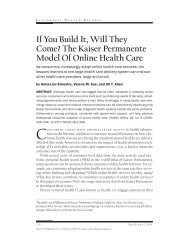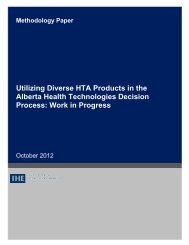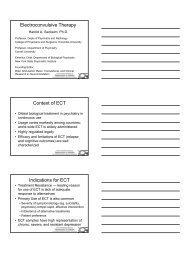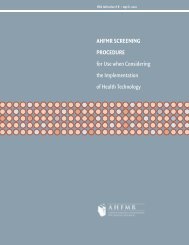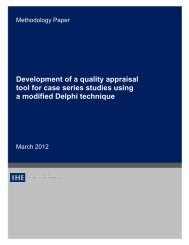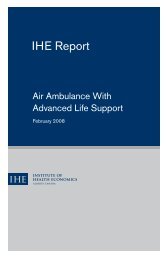Bariatric treatments for adult obesity - Institute of Health Economics
Bariatric treatments for adult obesity - Institute of Health Economics
Bariatric treatments for adult obesity - Institute of Health Economics
- No tags were found...
Create successful ePaper yourself
Turn your PDF publications into a flip-book with our unique Google optimized e-Paper software.
ConclusionCombined exercise and diet was the most cost-effective option <strong>for</strong> improving physicalfunction, pain, and stiffness <strong>for</strong> obese patients with knee osteoarthritis.16 Study 21 Authors/publish year: Roux/2006; country: US; study type: CUA; setting: outpatient care;study perspective: societyObjectiveTo assess the cost-effectiveness <strong>of</strong> weight loss programs in overweight and obese <strong>adult</strong>US women.Population Adult women aged ≥ 35 years with a BMI ≥ 25 kg/m 2 .InterventionTime Horizon/discount rateCurrency/priceyearResult<strong>Health</strong> outcomesCostsMarginal analysisUsual care was compared with four weight loss strategies: diet only, diet andpharmacotherapy, diet and exercise, and combined diet, exercise, and behaviourmodification. Exercise consisted <strong>of</strong> three 45-minute sessions per week and two monthlyreview sessions. Pharmacotherapy comprised <strong>of</strong> orlistat (120 mg) three times per day <strong>for</strong>initial 6 months, and half that dose <strong>for</strong> next 6 months. Behaviour modification consisted<strong>of</strong> cognitive counselling <strong>for</strong> 1 hour every 2 weeks.Lifetime/3%US$/2001Combined diet, exercise, and behaviour modification was the most effective option with24.17 discounted LY and 18.426 discounted QALY, followed by diet and exercise (24.129LY and 18.255), diet and pharmacotherapy (24.128 and 18.248), diet only (24.12 and18.169) and usual care (24.119 and 18.183).The lifetime cost was $124,200 <strong>for</strong> the combined diet, exercise, and behaviourmodification, $123,240 <strong>for</strong> diet and exercise, $122,660 <strong>for</strong> diet and pharmacotherapy,$122,440 <strong>for</strong> diet only, and $121,120 <strong>for</strong> usual care.The combined diet, exercise, and behaviour modification dominated other options withan ICER over usual care <strong>of</strong> $60,400 per LY gained and $12,640 per QALY gained.ConclusionThe weight loss program combining diet, exercise, and behaviour modification was themost cost-effective <strong>for</strong> overweight and obese women.17 Study 25 Authors/publish year: Gustafson/2009; country: US; study type: CEA; setting: primarycare; study perspective: payerObjectivePopulationInterventionTime Horizon/discount rateCurrency/priceyearTo assess the cost-effectiveness <strong>of</strong> a 16-week weight loss program.Women aged between 40 and 60 years with a BMI between 25 kg/m 2 and 45 kg/m 2 andincome ≤ 200% <strong>of</strong> the federal poverty level.The weight-wise intervention was compared with a wait-listed control group. The weightwiseintervention consisted <strong>of</strong> weekly counselling sessions during a 16-week period, with afocus on consuming nine or more fruit and vegetable servings daily and lifestyle changethrough self-monitoring, problem-solving, and goal-setting.Lifetime/3%US$/2007<strong>Bariatric</strong> <strong>treatments</strong> <strong>for</strong> <strong>adult</strong> <strong>obesity</strong> 195



